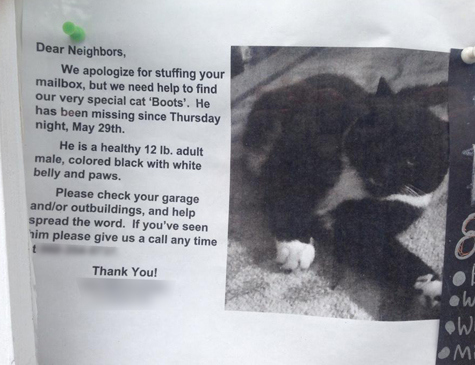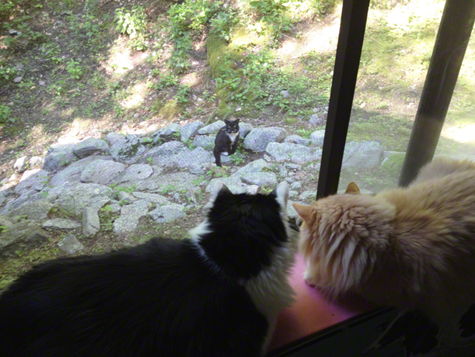
You are here
How to Help Stray Cats: a #BlogPawsDIY Special Post
I found a friendly cat! What do I do now?
How many of you have had cats “find” you? You’re minding your own business and a skinny, sad little waif shows up at your patio door looking for something to eat or you’re doing yard work and hear kittens crying. A cat has given birth under your shed.
There are countless ways you might find a cat or vice versa, but what do you do next? You’ve got to help them!
First things First. Is the cat Friendly or Feral?
Do you think the cat is a lost house-cat or a wild child? Sometimes it’s tough to tell the difference. In this insightful article, Alley Cat Allies shares some great tips on how to make the determination The short answer is, if they come over to you and want to be petted, you know it’s a friendly stray. In a future post we’ll talk about what to do if the cat is feral. For now we’ll focus on friendly cats.

A few weeks ago Sam spotted an unfamiliar cat outside on our deck so we began the process of finding out if he needed our help.
Friendly Cats
First, if the cat is NOT BADLY INJURED OR SERIOUSLY ILL* you MUST find out if this is someone else’s cat. It doesn’t matter if the cat appears to be in poor condition, very thin, dirty or not seriously injured. It may have lost its home a long time ago and it may still have a family looking for it. Call your local animal control and report a FOUND cat. Do not simply call them and ask them to take the cat away. Many municipalities do not take found cats and if they do they might euthanize the animal. What they might be able to do is scan the found cat for a microchip. Ask if they can help you with that. If they can’t do the scan, most vets can at least do that. If you can handle the cat and get it to a vet, finding that it has a chip may allow you to reunite it with its family.

Poor Boots is lost in New Milford, CT.
Also, put flyers around your neighborhood and post photos and information on social media. In some states there are state-specific lost and found web sites for pets. Take a moment to search for those, too. You might be surprised at what you find. Here's a group dedicated to finding lost pets in northwestern CT.

Keep your eyes peeled for signs in your town from folks looking for their lost cat. It might be the one you found!
If you can’t find their family, as you’re reaching out to get help from a rescue or shelter, be prepared to at least provide fresh food and water for the cat. Shelter is helpful especially if it’s very cold or hot where you live. A plastic storage bin turned on its side in a safe location without the lid works fine to keep the cat out of the elements. Add bedding but make sure to bag it and sanitize wash it after you’re done using it.

This is a special area where we feed our feral kitty, Bronte. A few weeks ago we noticed she had a new friend with her.
Next, go on petfinder.com and do a search for shelters and rescues in your area. Call and email each one that handles cats.
DO THE FOLLOWING
• Describe the cat as best you can. Is it a specific breed? Is it Long or short haired? What Color is it? Boy or girl or you can’t tell. Is it injured or pregnant? If it’s a kitten or kittens describe if their eyes are open yet, if they are blue, if their ears are perky or flat, if they can walk on their own or just wobble. The more you can tell the rescue, the better they will know what they’re dealing with and be able to figure out if they can help that animal.

Less than a day after posting this photo on Facebook a woman contacted me and said it might be the missing kitty, Boots. I contacted his family and they still need better images as they are not sure this is their boy, so I'm working on that right now. If it's not Boots, then this kitty is headed to our vet.
•Provide CLEAR photos of the cat’s face and body. Try to estimate age. Older cats lose muscle mass and have noticeable tooth wear and tear.
• Be willing to foster the found cat in your home for a short period of time. The space can be a spare room or bathroom, but do not let the new cat mix with your existing pets until that cat is completely vetted and treat the cat for fleas before you bring it inside unless they are less than 8 week old kittens. They'll need a bath if that's the case.
• If you can afford it, offer to provide whatever you can to make it easier on the rescue. Rescues often survive from day to day. They get calls all the time from people who need help but only want to dump a problem on them without being part of the rescue. THE MORE YOU CAN DO TO HELP MAKE IT EASY FOR A RESUCE TO SAY YES, DO IT BECAUSE IT WILL HELP YOU GET THE CAT A PLACEMENT.
• Offer a donation towards the care of the cat and you can get the cat its initial vetting. Have it tested for FIV and Feline Leukemia, have it de-wormed and de-flea’d and give him or her a Rabies vaccination. If the cat is intact, you can take it to a low cost clinic. You can find them listed by using the Petsmart & ASPCA locator below: The clinic can do the testing and vaccinations while the cat is being fixed usually all for under $100.00.
If you don’t have a low cost clinic in your area, talk to your own vet or call a local vet. Some will give a “good Samaritan” discount for services. Providing vet care for the cat will make most rescues take notice, because it's rarely ever done. You just saved them not only money, but time.
• Offer to transport the cat to their foster home or facility.
Be patient and be persistent. Expect not to get a call back right away, but don’t give up. You know the saying about the squeaky wheel…and GOOD LUCK!
Let’s save some lives!
Keep this post handy because some day you just might need it!
*IF THE CAT IS SERIOUSLY ILL OR INJURED TAKE IT TO A VET RIGHT AWAY. THEY OFTEN KNOW LOCAL RESCUES WHO CAN ASSIST YOU WITH PROVIDING CARE IF YOU ARE UNABLE TO. In some towns they DO ALLOW ANIMAL CONTROL TO HELP WITH INJURED CATS, too. It's worth a call to find out.
==================================
This post is sponsored by BlogPaws. I am being compensated for helping spread the word about DIY month, but Covered in Cat Hair only shares information we feel is relevant to our readers. BlogPaws is not responsible for the content of this article.


















Comments
Timely
This is such a timely post, as I had a stunningly beautiful Momcat appear on my back deck three days ago with four bouncy, playful kittens in tow. Their eyes have changed color, and they're in the stage where they're moving from fuzzy to swaggering kitten. They all appear extremely healthy, for the most part. I'm feeding them to keep them on the deck until I can figure out what to do with them.
Momcat is skittish but as she's beginning to associate me with food, she's tentatively lessening her boundaries and letting me come closer. She no longer bolts when I talk to her or move closer.
Of the four kittens, three are boys and one has to be a girl (tortoiseshell). One boy is outgoing, friendly, demanding, and comes running when I call. The other two boys are more suspicious, but one loves to snuggle and be held; the other one is not interested and will subject to a few pets before slinking off.
The girl I can't get near, and what worries me is that she is limping. Her hind leg looks like either she was born with a deformity, or that it was injured and is fused into position (walking/sitting/angled). It could also be so swollen and painful that it only appears fused. I've seen her hop along and put some weight on it. I've also seen her use the foot to scratch at her ear with vigor. I know I need to catch her and get her into the vet soon.
Do rescues have traps to borrow? That's my main issue. Do I trap all at once or trap who I can? I worry if kittens "go missing", Momcat will move everyone; or if I get Momcat while some babies are hiding under my deck, I may never get them out. (They take shifts appearing on deck to eat.)
At the moment, I'm just focusing on feeding them, getting them used to me, and trying to socialize them as much as possible. I guess I should be glad I don't have to bottlefeed four kittens right now. But with four strictly indoor cats (who are separate, as are all clothing I wear when with either set), this brings the total to nine. It's a bit much! Any further advice is appreciated.
TYSM for this expert and
TYSM for this expert and detailed advice. Shared it on twitter with RT request. Hoping this helps a lot of ppl who are goodhearted but do not have all the facts you have outlined here.
Traps
Great post!
I haven't found a stray cat, but we do see a lot of lost cat posters in our area and we thought we lost one of our cats for a short period last year.
It's helpful to have a step by step of what I can do. One thing I've seen people doing is use plastic covers on their flyers so that they survive the rainy days.
Add new comment